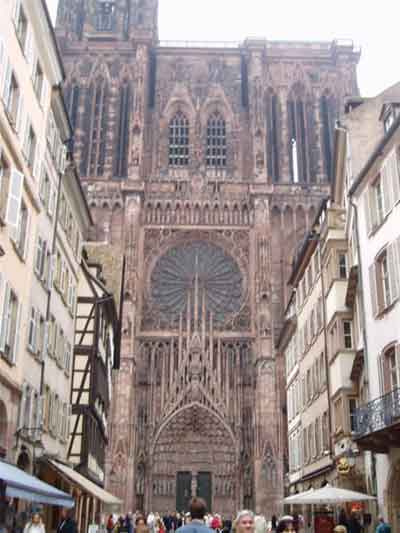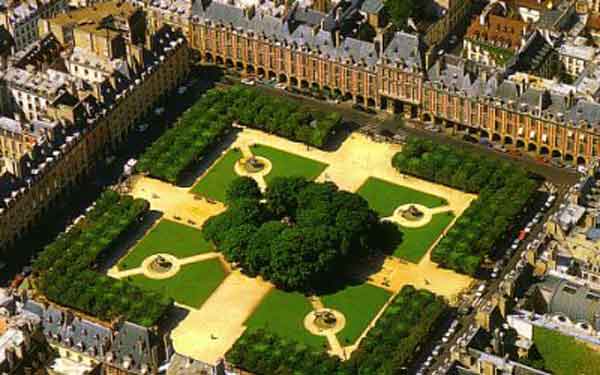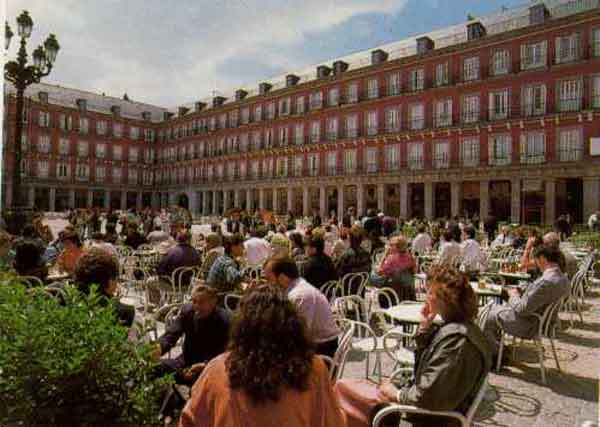

050 the inside-out building
The
west front of Strasbourg Cathedral. Architecture implies space enclosed
by walls; urban design deals with the open space between walls. That
space, whether a square or a simple street, can be an artistic whole as
much as any individual building-a kind of a building that's 'inside
out'.
The street leading to the portal may be a little wider than it was in medieval times, but the effect has not changed. Medieval cities weren't always highly crowded places; Paris was, and so was Strasbourg—in these cities, a street thirty feet wide had the same visual effect as a piazza. Working from the constraints of high density and property values, the cathedral builders in both employed a novel trick of design to highlight their façade. A Baroque or Neoclassical architect might sight a monument at the end of a broad boulevard, to highlight the building and close the view on the street. The Strasbourg builders (like those at Nôtre-Dame-de-Paris) made use of a narrow street as a kind of funnel to focus attention on the prime sculptural element of the cathedral, the portal, thus creating a unique urban space. We are more familiar with this kind of design in what is called an 'architectural square', an open space in which the surrounding buildings have been treated as an ensemble, an architectural whole. These belong to the sphere of formal planning [link to formal and informal]. Some grand examples exist from antiquity, such as the agoras of Miletus and Priene, or Trajan's Forum in Rome, and there must have been many smaller ones in places where the Hellenistic Greeks and Romans built new towns all at once. This manner of design found favor again in the Renaissance, and the inside-out building reached its fullest development in the 1600's, in the royal squares of Paris: Place des Vosges (originally Place Royale), Place Vendôme, Place Dauphine in front of the Pont Neuf, and the circular Place des Victoires. 
Place des Vosges* in the Marais, planned c. 1600
by good King Henri IV. (Just coincidentally, Henri owned the
land in and around the new square, and the development made the royal family
a pretty profit. That's why he and his successors built so many others.)

Plaza Mayor, Madrid.
The Spaniards picked up the fashion from France, and besides the original in Madrid quite a few cities, such as Barcelona and Córdoba, have their own versions. This one, complete by 1620 (though substantially rebuilt later after fires) was occasionally used for bullfights and other spectacles, with the fortunate aristocrats in the townhouses looking on from their balconies. Every square of this era, in truth, was intended as a kind of stage for the decorous comings and goings of Baroque life. This was also the golden age of the Spanish theatre, and not coincidentally, the very buildings where the works of Calderón and Lope de Vega were performed looked just like a little Plaza Mayor, with theatre boxes in place of the townhouse windows, and a stage at one narrow end. *note on Place des Vosges....Advanced students of urban design might look closely at the façade that surrounds the Place, and what lies behind it. A part of the building that covered four arches (of the arcade that surrounds the square) represents one townhouse of the original plan, of which nine stood on each side. Look behind the facades in this photo to see how the aristocratic owners, from the beginning, expanded their Paris pied-a-terres into the space behind the square.. Place des Vosges was an island of order and uniformity, a symbol of the harmony the new Bourbon monarchy hoped it might bring to France. But behind the façade the old urban anarchy reigns, born of individual needs and desires and whims and fancies. Owners built new wings and courtyards as they saw fit, as they could afford. To me this square captures all the humanity and liberality of the anciens régimes of old Europe. On the surface, you had to go along; behind the façade, you could do what you damn well pleased. There's a useful principle here, even for towns lacking in Bourbons and dukes and counts. A kind of design that balances the demands of community with the rights of the individual-symbolizes that balance, even, in brick and stone. A kind of design that takes an aristocratic building and turns it inside out, to become a public square-instead of an enclosing, an embracing. Could there be a way to translate these principles-almost magical principles, to our blinkered world-into an idea that contemporary design could use? There might be, but it would probably fall foul of the zoning codes in every city in America. |
|